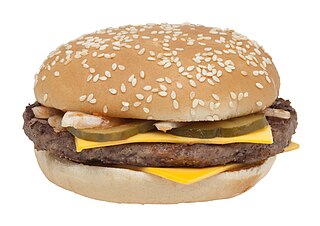
A hamburger or simply burger is a food consisting of fillings—usually a patty of ground meat, typically beef—placed inside a sliced bun or bread roll. Hamburgers are often served with cheese, lettuce, tomato, onion, pickles, bacon, or chilis; condiments such as ketchup, mustard, mayonnaise, relish, or a "special sauce", often a variation of Thousand Island dressing; and are frequently placed on sesame seed buns. A hamburger patty topped with cheese is called a cheeseburger.

The Big Mac is a hamburger sold by the international fast food restaurant chain McDonald's. It was introduced in the Greater Pittsburgh area in 1967 and across the United States in 1968. It is one of the company's flagship products and signature dishes. The Big Mac contains two beef patties, cheese, shredded lettuce, pickles, minced onions, and a Thousand Island-type dressing advertised as "special sauce", on a three-slice sesame-seed bun.
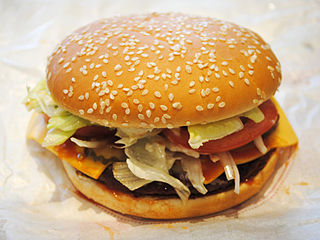
The Whopper is the signature hamburger and an associated product line sold by the international fast food restaurant chain Burger King and its Australian franchise Hungry Jack's. Introduced in 1957, the hamburger has undergone several reformulations, including changes to portion size and bread used. The hamburger is well known in the fast food industry, with Burger King advertising itself as "the Home of the Whopper" and naming its kiosk stores the BK Whopper Bar. In response to the Whopper, Burger King's competitors have developed similar products designed to compete against it.
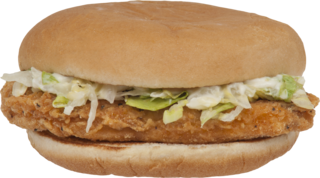
The McChicken is a chicken sandwich sold by the international fast food restaurant McDonald's. In some countries, such as Australia, India, New Zealand, and the UK, it is considered to be a chicken burger, especially given it is not a sandwich as that word is understood in some of those non-American varieties of English. It consists of a toasted wheat bun, a breaded patty, shredded lettuce and mayonnaise.
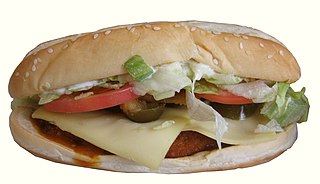
The TenderCrisp is a chicken sandwich sold by international fast-food restaurant chain Burger King and its Australian franchisee, Hungry Jack's. It is one of their "indulgent" products.
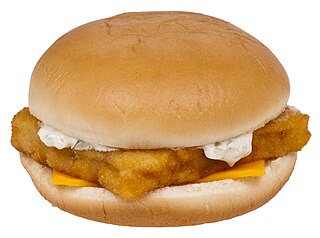
The Filet-O-Fish is a fish sandwich sold by the international fast food restaurant chain McDonald's. It was created in 1962 by Lou Groen, a McDonald's franchise owner in a predominantly Catholic neighborhood in Cincinnati, Ohio, in response to declining hamburger sales on Fridays due to the practice of abstaining from meat on that day. While the fish composition of the sandwich has changed through the years to cater to taste preferences and address supply limitations, the framework of its ingredients have remained constant; a fried breaded fish fillet, a steamed bun, tartar sauce and pasteurized American cheese.

The Big King sandwich is one of the major hamburger products sold by the international fast-food restaurant chain Burger King, and was part of its menu for more than twenty years. As of March 2019, it is sold in the United States under its 1997 Big King XL formulation. During its testing phase in 1996–1997, it was originally called the Double Supreme and was configured similarly to the McDonald's Big Mac—including a three-piece roll. It was later reformulated as a more standard double burger during the latter part of product testing in 1997. It was given its current name when the product was formally introduced in September 1997, but maintained the more conventional double cheeseburger format.

A&W is a fast-food restaurant chain in Canada, franchised by A&W Food Services of Canada, Inc.

BK Chicken Fries are a fried chicken product sold by the international fast-food restaurant chain Burger King. At the time of their introduction in 2005, the company had intended Chicken Fries to be one of their larger, adult-oriented products made with higher-quality ingredients than their standard menu items. Additionally, the product further targeted the snacking and convenience food markets with a specific packaging design that was intended to be easier to handle and fit into automotive cup holders. The product was part of a series of product introductions designed to expand Burger King's menu with both more sophisticated fare and present a larger, meatier product that appealed to 24- to 36-year-old males. Along with this series of larger, more complex menu products, the company intended to attract a larger, more affluent adult audience who would be willing to spend more on the better-quality products. They were discontinued in the United States in 2012, but continued to be sold in some markets, such as Italy. In August 2014, they were reintroduced for a limited-time offering (LTO) in North America, leading to their permanent re-addition to the menu in March 2015 in over 30 countries globally.

The Burger King Specialty Sandwiches are a line of sandwiches developed by the international fast-food restaurant chain Burger King in 1978 and introduced in 1979 as part of a new product line designed to expand Burger King's menu with more sophisticated, adult oriented fare beyond hamburgers. Additionally, the new line was intended to differentiate the company from other fast food hamburger restaurants at the time. Since the line's introduction, the other sandwiches have been discontinued, leaving the chicken offering, the Original Chicken Sandwich, as the primary product left. Additionally, other sandwiches that utilize the same roll as the chicken sandwich have been introduced to the company's menu both domestically and internationally since the original product line was introduced.
As far back as the 1970s, international fast food restaurant chain Burger King has attempted to introduce a premium line of burgers. These sandwiches are part of a system which eventually became known as the barbell strategy; a plan designed to expand Burger King's menu with both more sophisticated, adult-oriented fare along with products that are more value-oriented. This program is intended to bring in a larger, more affluent adult audience who will be willing to spend more on the better quality products on one side while maintaining a lower cost value menu dedicated to a more cost-conscious audience on the other. The hope is that the customers would be drawn in initially for the lower prices of the value-menu and upgrade to the more expensive products, upping overall sales.
When the predecessor of international fast food restaurant chain Burger King (BK) first opened in 1953, its menu predominantly consisted of hamburgers, French fries, soft drinks, milkshakes, and desserts. After being acquired by its Miami, Florida franchisees and renamed in 1954, BK began expanding its menu by adding the Whopper sandwich in 1957, and has since added non-beef items such as chicken, fish, and vegetarian offerings, including salads and meatless sandwiches. Other additions include a breakfast menu and beverages such as Icees, juices, and bottled waters. As the company expanded both inside and outside the United States, it introduced localized versions of its products that conform to regional tastes and cultural or religious beliefs. To generate additional sales, BK occasionally introduces limited-time offers of special versions of its products, or brings out completely new products intended for either long- or short-term sales. Not all of these products and services have been successful; in 1992, Burger King introduced limited table service featuring special dinner platters, but this concept failed to generate interest and was discontinued.

The McDonald's Deluxe line was a series of sandwiches introduced in the early to mid 1990s and marketed by McDonald's with the intent of capturing the adult fast food consumer market, presented as a more sophisticated burger for adult tastes. The sandwiches sold poorly and the entire line was discontinued on August 18, 2000. The Deluxe series was a marketing disaster and is now considered to be one of the most expensive flops in McDonald's history.

The McDonald's Premium line is a group of products introduced by McDonald's in the spring of 2003. It includes the company's larger chicken sandwiches, its salad line, and its coffee products. The sandwiches are targeted at various demographic markets, the grilled chicken sandwiches and salads are targeted at both the female and health-conscious demographic markets. The entire line is intended to bring in a larger, more affluent, adult audience seeking better quality products.
McDonald's Corporation is the world's largest chain of fast food restaurants, serving around 68 million customers daily in 119 countries. McDonald's traces its origins to a 1940 restaurant in San Bernardino, California. After expanding within the United States, McDonald's became an international corporation in 1967, when it opened a location in Richmond, British Columbia, Canada. By the end of the 1970s, McDonald's restaurants existed in five of the Earth's seven continents; an African location came in 1992 in Casablanca, Morocco.

The Big N’ Tasty is a hamburger sold by the international fast food chain McDonald's. It is designed to compete with the Whopper sandwich. A similar variation called the Big Tasty, without the center "N'", which was first released in Saudi Arabia, is sold outside the United States in parts of Europe, South America, South Africa, The Middle East, and Taiwan.

The fast-food restaurant chain Burger King was the first major fast food chain to introduce a grilled chicken sandwich to the marketplace, in 1990, six months before Wendy's and four years before McDonald's. Since then, Burger King, and its Australian franchise Hungry Jack's have offered a variety of grilled chicken sandwiches, as have Wendy's and McDonald's.
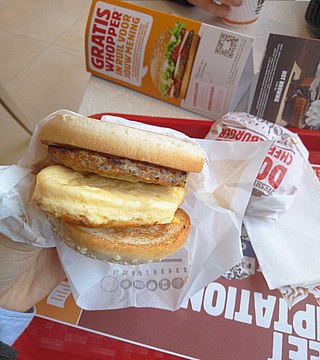
International fast-food restaurant chain Burger King and its Australian franchise Hungry Jack's have had a variety of breakfast sandwiches in their product portfolio since 1978. The Croissan'wich was the first major breakfast sandwich product introduced by the company.















